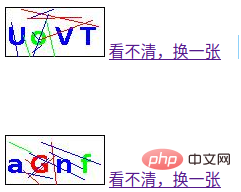Java implements dynamic picture verification code

Purpose:
Prevent malicious form registration
Generate verification code image
1. Define width and height
int width = 100; int height = 50;
2. Use BufferedImage to generate images in memory
BufferedImage image = new BufferedImage(width, height, BufferedImage.TYPE_INT_RGB);
3. Draw background and borders
Graphics g = image.getGraphics(); g.setColor(Color.WHITE); g.fillRect(0, 0, width, height); g.setColor(Color.BLACK); g.drawRect(0, 0, width - 1, height - 1);
(Free learning video tutorial sharing: java video tutorial)
4. Create a random character set and random number object
//字符集 String str = "ABCDEFGHIJKLMNOPQRSTUVWXYZabcdefgjijklmnopqrstuvwxyz"; //随机数 Random ran = new Random();
5. Create a random color generation method
private Color getRandomColor(Random random) {
//获取随机颜色
int colorIndex = random.nextInt(3);
switch (colorIndex) {
case 0:
return Color.BLUE;
case 1:
return Color.GREEN;
case 2:
return Color.RED;
case 3:
return Color.YELLOW;
default:
return Color.MAGENTA;
}
}6. Draw Verification code characters
//绘制验证码
for (int i = 0; i < 4; i++) {
//获取随机字符
int index = ran.nextInt(str.length());
char ch = str.charAt(index);
//获取随机色
Color randomColor = getRandomColor(ran);
g.setColor(randomColor);
//设置字体
Font font = new Font("宋体", Font.BOLD, height / 2);
g.setFont(font);
//写入验证码
g.drawString(ch + "", (i == 0) ? width / 4 * i + 2 : width / 4 * i, height - height / 4);
}7, draw interference lines
//干扰线
for (int i = 0; i < 10; i++) {
int x1 = ran.nextInt(width);
int x2 = ran.nextInt(width);
int y1 = ran.nextInt(height);
int y2 = ran.nextInt(height);
Color randomColor = getRandomColor(ran);
g.setColor(randomColor);
g.drawLine(x1, x2, y1, y2);
}8, use ImageIO to output pictures
ImageIO.write(image, "jpg", resp.getOutputStream());

to achieve refresh effect
1. Create a new html page
2. Use the img tag to display images
<img src="/static/imghw/default1.png" data-src="identcode" class="lazy" id="identcode" alt="Java implements dynamic picture verification code" > <a id="refesh" href="">看不清,换一张</a>
3. Use js to achieve the refresh effect
//点击图片时
var img = document.getElementById("identcode");
img.onclick = function (){
refesh();
}
//点击连接时
var a = document.getElementById("refesh");
a.onclick = function (){
refesh();
//返回false防止a标签默认href行为
return false;
}
function refesh() {
/**
* 由于路径相同时浏览器会自动调用缓存中的图片
* 所以在连接后加时间戳解决此问题
*/
var date = new Date().getTime();
img.src = "identcode?" + date;
}Finally Rendering:

Recommended related articles and tutorials: java introductory tutorial
The above is the detailed content of Java implements dynamic picture verification code. For more information, please follow other related articles on the PHP Chinese website!

Hot AI Tools

Undresser.AI Undress
AI-powered app for creating realistic nude photos

AI Clothes Remover
Online AI tool for removing clothes from photos.

Undress AI Tool
Undress images for free

Clothoff.io
AI clothes remover

Video Face Swap
Swap faces in any video effortlessly with our completely free AI face swap tool!

Hot Article

Hot Tools

Notepad++7.3.1
Easy-to-use and free code editor

SublimeText3 Chinese version
Chinese version, very easy to use

Zend Studio 13.0.1
Powerful PHP integrated development environment

Dreamweaver CS6
Visual web development tools

SublimeText3 Mac version
God-level code editing software (SublimeText3)

Hot Topics
 1664
1664
 14
14
 1421
1421
 52
52
 1315
1315
 25
25
 1266
1266
 29
29
 1239
1239
 24
24
 Break or return from Java 8 stream forEach?
Feb 07, 2025 pm 12:09 PM
Break or return from Java 8 stream forEach?
Feb 07, 2025 pm 12:09 PM
Java 8 introduces the Stream API, providing a powerful and expressive way to process data collections. However, a common question when using Stream is: How to break or return from a forEach operation? Traditional loops allow for early interruption or return, but Stream's forEach method does not directly support this method. This article will explain the reasons and explore alternative methods for implementing premature termination in Stream processing systems. Further reading: Java Stream API improvements Understand Stream forEach The forEach method is a terminal operation that performs one operation on each element in the Stream. Its design intention is
 PHP: A Key Language for Web Development
Apr 13, 2025 am 12:08 AM
PHP: A Key Language for Web Development
Apr 13, 2025 am 12:08 AM
PHP is a scripting language widely used on the server side, especially suitable for web development. 1.PHP can embed HTML, process HTTP requests and responses, and supports a variety of databases. 2.PHP is used to generate dynamic web content, process form data, access databases, etc., with strong community support and open source resources. 3. PHP is an interpreted language, and the execution process includes lexical analysis, grammatical analysis, compilation and execution. 4.PHP can be combined with MySQL for advanced applications such as user registration systems. 5. When debugging PHP, you can use functions such as error_reporting() and var_dump(). 6. Optimize PHP code to use caching mechanisms, optimize database queries and use built-in functions. 7
 PHP vs. Python: Understanding the Differences
Apr 11, 2025 am 12:15 AM
PHP vs. Python: Understanding the Differences
Apr 11, 2025 am 12:15 AM
PHP and Python each have their own advantages, and the choice should be based on project requirements. 1.PHP is suitable for web development, with simple syntax and high execution efficiency. 2. Python is suitable for data science and machine learning, with concise syntax and rich libraries.
 PHP vs. Other Languages: A Comparison
Apr 13, 2025 am 12:19 AM
PHP vs. Other Languages: A Comparison
Apr 13, 2025 am 12:19 AM
PHP is suitable for web development, especially in rapid development and processing dynamic content, but is not good at data science and enterprise-level applications. Compared with Python, PHP has more advantages in web development, but is not as good as Python in the field of data science; compared with Java, PHP performs worse in enterprise-level applications, but is more flexible in web development; compared with JavaScript, PHP is more concise in back-end development, but is not as good as JavaScript in front-end development.
 PHP vs. Python: Core Features and Functionality
Apr 13, 2025 am 12:16 AM
PHP vs. Python: Core Features and Functionality
Apr 13, 2025 am 12:16 AM
PHP and Python each have their own advantages and are suitable for different scenarios. 1.PHP is suitable for web development and provides built-in web servers and rich function libraries. 2. Python is suitable for data science and machine learning, with concise syntax and a powerful standard library. When choosing, it should be decided based on project requirements.
 PHP's Impact: Web Development and Beyond
Apr 18, 2025 am 12:10 AM
PHP's Impact: Web Development and Beyond
Apr 18, 2025 am 12:10 AM
PHPhassignificantlyimpactedwebdevelopmentandextendsbeyondit.1)ItpowersmajorplatformslikeWordPressandexcelsindatabaseinteractions.2)PHP'sadaptabilityallowsittoscaleforlargeapplicationsusingframeworkslikeLaravel.3)Beyondweb,PHPisusedincommand-linescrip
 Java Program to Find the Volume of Capsule
Feb 07, 2025 am 11:37 AM
Java Program to Find the Volume of Capsule
Feb 07, 2025 am 11:37 AM
Capsules are three-dimensional geometric figures, composed of a cylinder and a hemisphere at both ends. The volume of the capsule can be calculated by adding the volume of the cylinder and the volume of the hemisphere at both ends. This tutorial will discuss how to calculate the volume of a given capsule in Java using different methods. Capsule volume formula The formula for capsule volume is as follows: Capsule volume = Cylindrical volume Volume Two hemisphere volume in, r: The radius of the hemisphere. h: The height of the cylinder (excluding the hemisphere). Example 1 enter Radius = 5 units Height = 10 units Output Volume = 1570.8 cubic units explain Calculate volume using formula: Volume = π × r2 × h (4
 PHP: The Foundation of Many Websites
Apr 13, 2025 am 12:07 AM
PHP: The Foundation of Many Websites
Apr 13, 2025 am 12:07 AM
The reasons why PHP is the preferred technology stack for many websites include its ease of use, strong community support, and widespread use. 1) Easy to learn and use, suitable for beginners. 2) Have a huge developer community and rich resources. 3) Widely used in WordPress, Drupal and other platforms. 4) Integrate tightly with web servers to simplify development deployment.




